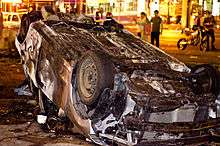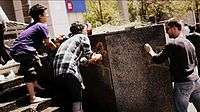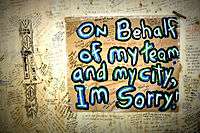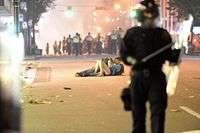2011 Vancouver Stanley Cup riot
|
Smoke billowing from fires in downtown Vancouver during the riot | |
| Time | 7:45 p.m - 12:00 a.m. (PDT)[1] |
|---|---|
| Date | June 15, 2011 |
| Location | Downtown Vancouver |
| Also known as | Vancouver riots[2] |
| Deaths | ? |
| Non-fatal injuries | 140 (1 critically injured, 3 seriously)[3] |
| Property damage |
$5 million CAD (Estimated)[4] ($5.29 million in 2016 dollars[5]) |
The 2011 Vancouver Stanley Cup riot was a public disturbance that broke out in the downtown core of Vancouver, British Columbia, Canada on Wednesday, June 15, 2011. The riot happened immediately after the conclusion of the Boston Bruins' win over the Vancouver Canucks in game seven of the Stanley Cup Finals, which won the Stanley Cup for Boston. At least 140 people were reported as injured during the incident, 1 critically;[1][3] at least 4 people were stabbed, 9 police officers were injured, and 101 people were arrested that night.[6][7] In July 2015, four years after the riot, police finished their investigation and recommended the final charges against two suspects, bringing the total to 887 charges laid against 301 people.[8]
Background
City organizers had set up a two-block long fan zone on six-lane Georgia Street near the Rogers Arena. Two big screen TVs were set up for fans to watch the game.[9] Temporary fences and gates were set up to provide checkpoints where police could control access to the area and check for alcohol (which police generally poured out when found). Following recommendations stemming from the 1994 riot, all liquor stores in the area were closed earlier in the day.[10] Crowds had been generally well-behaved in the fan zone for the previous six games, with roughly 70,000 attending each event. Similar though smaller events had been very successful during the 2010 Winter Olympics. For the final game, an estimated 100,000 people crowded into the area, and people found ways to enter the zone without being checked for alcohol. Planned corridors to allow movement of emergency vehicles became impassable.[11]
Violence frequently occurs in the wake of sporting events in North America and Europe.[12] The 2011 Vancouver riot is consistent with past Stanley Cup riots in Canada. In the previous twenty years, Vancouver itself had riots following the Canucks' defeat in 1994, while Edmonton Oilers fans set fires and looted in the Whyte Avenue ("Blue Mile") area of Edmonton when the team qualified for the 2006 finals, and Montreal was vandalized by Montreal Canadiens fans after both the 1993 title and during the 2008 and 2010 playoffs.[13]
Riot

The riot began to take shape as the game came to a close at 7:45 pm, with some spectators throwing bottles and other objects at the large screens in the viewing area.[1] Boston Bruins flags and Canucks jerseys were set afire, and soon some rioters overturned a vehicle in front of the main post office.[1] According to one eyewitness, a group who was heard chanting "Let's go riot, let's go riot" as early as the first period of the game were among those responsible for flipping the first car.[14] Fist fights broke out when people standing on porta-potties fell when others tipped the porta-potties over. People began jumping on the car that had been first overturned; it was set afire at 7:46.[15] With a crowd of onlookers chanting "burn the truck", a second vehicle in the same area was lit ablaze. Firemen were able to put it out,[16] but the truck was again set afire after it was overturned. In a nearby parking lot, two Vancouver Police squad cars were later also set on fire.[17][18][19][20] In total, 17 cars were burned, including police cars. Windows were smashed in a bank and various businesses along the West Georgia corridor, some of which were also looted. Riot police eventually managed to push the rioters away from Georgia, onto Granville Street and Robson Street, where the rioters then caused further substantial damage, breaking the windows of several shops and looting. Some of the stores affected were Future Shop, Sears and Chapters bookstore. One man was sent to hospital in critical condition after he attempted to jump from the Georgia Viaduct onto another platform and fell.[21] Several hundred theatergoers were attempting to leave after a showing of the Broadway musical Wicked but were trapped and remained inside the Queen Elizabeth Theatre, which was situated in the riot zone.[22][23] Transit authorities diverted or halted bus routes normally running through the affected area, and police closed bridge lanes into the city so that people could leave the area but further arrivals were restricted. By midnight, the majority of the crowd had dispersed. The Vancouver Police Department made 101 arrests during the riot. 85 people were arrested for breach of peace, eight for public intoxication and eight for breaking and entering, assault or theft.[24]
Aftermath

Response
Vancouver mayor Gregor Robertson attributed the situation to "a small group of troublemakers".[25] Vancouver Police Department chief Jim Chu said that instigators appeared to be some of the same individuals involved in a protest on the opening day of the 2010 Winter Olympics, and that they came equipped with eye protection, gasoline and other tools. He called them "criminals and anarchists" who disguised themselves as fans.[25][26] The idea that anarchists were involved in the violence was rejected by UBC political science professor Glen Coulthard, and others in a Vancouver Sun article on June 24. "That this gets tagged as anarchist activity is just more of an assumption or bias that has been around for a long time," said Coulthard. "[A]narchists are a convenient scapegoat for the police to deflect responsibility for what happened," said another commentator.[27] One critic indicated that authorities had made several mistakes in the planning for the crowd - among them allowing parked cars near the screens and leaving newspaper boxes nearby which could be used as projectiles.[28]


Cleanup
After the riot, thousands of volunteers organized on social media sites such as Facebook, Twitter and they texted on phones to clean up the damage. The estimated 15,000 volunteers,[29] many taking a day off work, had stated that they went downtown to clean up the damage to "... show that not all Canucks fans are like that".[30] Streets were reportedly clean by 10 am, with volunteers having shown up with brooms and dustpans to clean the city. Boarded up windows were covered in apologies and defences of the city's reputation. In response, the Hudson's Bay Company, a major retailer in the area, hosted a free pancake breakfast in thanks.[31]
Criminal prosecution
An investigative team of up to 70 officers from 8 different police agencies formed the Integrated Riot Investigation Team, which was tasked with sifting through hundreds of hours of video and other evidence to determine the identity of those who took part in the riot.[32][33] Several participants in the riots have turned themselves in to police after their faces were broadcast on TV,[34] including the person responsible for setting the first car on fire. More than 1,000,000 photos and 1,200 - 1,600 hours of video recorded by citizens have been sent to the Vancouver Police Department as evidence.[35][36][37] As of July 2013, police recommended 1,204 criminal charges against 352 suspected rioters.[38][39] In July 2015, over four years after the riots, the last two suspects were charged.[8] By then, a total of 887 criminal charges had been laid against 301 suspects, 274 of which plead guilty.[8] However police said they would continue to act on any tips they are provided and future charges could be laid.[8]
Insurance Corporation of British Columbia (ICBC) offered their facial-recognition software to the police in an attempt to aid in their criminal investigation of the riot. This is an example of "function creep", a technology being created for a particular use and then being used for another purpose than what it was originally created for,[40] something that ultimately widens the surveillance net to anyone who has a driver's license or government-issued identification card from ICBC.[41]
Social media
Following the riot, people were initially concerned about the role that social media may have played in fueling the riot.[42] Christopher Schneider, a sociologist from the University of British Columbia says that there is not a lot of evidence to support that theory.[42] Also important to note is that it can be difficult to discern sarcasm from honest, real intentions online.[43] Social media did, however, play a large role during and after the riot.
Many participants in the riot stood and posed for photographs, with some even posting the photos on their own social media accounts. Photos and videos were also taken by onlookers intent on documenting the riot. In the aftermath, those photos and videos were used by many local people outraged by the riot, in an effort to tag and identify rioters and looters on Facebook, YouTube, and other social media sites, and to provide additional information to police for prosecution.[44] Community participation in assisting police to identify the rioters has been described as unprecedented,[45] and police admitted to being overwhelmed by the amount of evidence provided.[46] While riot instigators were described by police as a small group of anarchists, the collected photographs and videos revealed that many participants were not connected and had never been arrested before.[47][48] Online shaming campaigns resulted in some riot participants being fired from their jobs and removed from athletic teams. In some cases, violence was threatened against those identified as rioters, prompting one family to flee its home,[49] and others to express concern about the potential of mob mentality online.[50] The Vancouver Police Department appealed to citizens, online and otherwise, not to engage in acts of vigilante justice.[51] A published study on social media vigilante justice, or "crowd-sourced policing", authored by sociologists Christopher Schneider and Daniel Trottier concluded that online vigilantes can slow police investigations.[52][53]
An issue related to social media and the riot police investigation was that a number of people involved in the rioting were under the age of 18. Names of minors are banned in the legal system.[54] On social media, however, the sharing of images and videos alongside public shaming online can end up identifying the accused.[54]
Financial losses
CBC News reported that the destruction caused by the rioters was worse than the riot that followed the Canucks loss in Game 7 of the 1994 Stanley Cup Finals, particularly the looting aspects. Early estimates suggested the losses due to vandalism, theft, and damage to property to be nearly $4.2 million.[4] Several large-scale stores such as London Drugs, The Bay, Sears Canada and Future Shop were among many that were looted.[55]
Investigation
A report released September 1, 2011 says that contributing factors to the riot were the number of people who attended the event and the level of alcohol consumption. With 155,000 people in an area meant to hold the expected 50,000, the situation deteriorated into a riot with hot spots spread over a large area, and the police's ability to control it were impeded by communication problems and location of equipment.[56]
An independent review commissioned by the Province of British Columbia and the City of Vancouver released its 396-page report on August 31, 2011.[15]
Media coverage

The riots sparked intense media coverage and attention on the local, national, and international level. Local media coverage of the riots began almost immediately after the game ended, with the local CBC, CTV and Global BC stations all running news coverage of the riots, with CTV and CBC doing so from studios located in downtown Vancouver itself.[57][58] CBC News Network started running live coverage in conjunction with its nationally broadcast evening news show The National, with one reporter calling in her reports from inside the riot.[59]
Prominent publications such as the The Atlantic, The Guardian, The New York Times and USA Today ran editorials critical of the riots and those who participated in them, as well as the city, marking the stark contrast between the Stanley Cup playoffs and the 2010 Winter Olympics.[60][61] The Boston Herald provided coverage of the riots in addition to coverage of the Bruins' Stanley Cup celebrations, with other Boston media outlets providing their coverage of the riots.[62]
A photograph of a young couple kissing in a riot-torn street became an iconic image of the riots.[63] Sports Illustrated called it "the most compelling sports image of the year".[12] At first many viewers suspected the scene had been staged. Evidence soon revealed that the Canadian woman, Alexandra Thomas of Coquitlam, B.C., had been knocked down by police; her Australian boyfriend, Scott Jones from Perth, W.A., was comforting her.[64][12] As of June 2012 Thomas and Jones live in Australia, where they sleep under a poster copy of the photograph.[65] The photograph is used as the album cover of A Place for Us to Dream, a compilation album by the English alternative rock band Placebo.
See also
References
- 1 2 3 4 Lindsay, Bethany (June 16, 2011). "From bad to brutal: Timeline of a riot". CTV Vancouver News. Retrieved September 14, 2015.
- ↑ "Scott Jones And Alex Thomas: Kissing Couple At Vancouver Riot Identified". CBC. June 17, 2011. Retrieved September 14, 2015 – via The Huffington Post.
- 1 2 "A tale of two riots Comparing the 1994 and 2011 Stanley Cup riots in Vancouver CBC June 16, 2011". Cbc.ca. June 14, 1994. Retrieved June 16, 2011.
- 1 2 Bailey, Ian (June 20, 2011). "Bill for damages to be much higher than for the 1994 Vancouver riot". Toronto: Globe and Mail. Retrieved June 21, 2011.
- ↑ Canadian inflation numbers based on Statistics Canada. "Consumer Price Index, historical summary". CANSIM, table (for fee) 326-0021 and Catalogue nos. 62-001-X, 62-010-X and 62-557-X. And Consumer Price Index, by province (monthly) (Canada) Last modified 2016-01-22. Retrieved March 2, 2016
- ↑ "Riots erupt in Vancouver after Canucks loss". June 13, 2014. Retrieved February 1, 2016.
- ↑ "Nine cops hurt, 150 injured during Vancouver riot". CP24. Retrieved February 1, 2016.
- 1 2 3 4 "Stanley Cup riot investigation winds down as last two suspects charged". www.vancouversun.com. Retrieved 2015-10-11.
- ↑ Luba, Frank; Chan, Cheryl (June 5, 2011). "Canucks fan zone moved from Granville to Georgia". Canada.com. The Province. Retrieved September 14, 2015.
- ↑ Newcomb, Tim (June 15, 2011). "Vancouver Prepares for Massive Stanley Cup Crowds – By Closing Liquor Stores". TIME. Retrieved December 3, 2013.
- ↑ Laanela, Mike (June 15, 2011). "Canucks testing faith in jammed fan zones". CBC News. Retrieved December 3, 2011.
- 1 2 3 Ballard, Steve (December 26, 2011). "The Kiss". Sports Illustrated. Retrieved December 24, 2011.
- ↑ "Here's a list of significant hockey riots in Canada". The Hockey News. June 15, 2011. Retrieved September 14, 2015.
- ↑ Kennedy, Jennifer (June 18, 2011). "Who's to blame for the riots?". National Post. p. A25. Retrieved June 18, 2011.
- 1 2 Furlong, John; Keefe, Douglas (August 31, 2011). The Night the City Became a Stadium INDEPENDENT REVIEW OF THE 2011 VANCOUVER STANLEY CUP PLAYOFFS RIOT (PDF). Vancouver, BC, Canada: Independent Review of the 2011 Vancouver Stanley Cup Playoffs Riot. Archived (PDF) from the original on May 13, 2012. Retrieved January 4, 2015.
- ↑ "Vancouver riots timeline". Toronto: The Globe and Mail. June 16, 2011. Retrieved June 21, 2011.
- ↑ Mike Hager; Andrea Woo; Adrienne Tanner (June 16, 2011). "Downtown Vancouver rocked by Stanley Cup post-game riot". Vancouver Sun. Retrieved June 16, 2011.
- ↑ "Angry Canucks fans set cars ablaze, fling bottles after loss". Toronto Star. The Canadian Press. June 16, 2011. Retrieved June 16, 2011.
- ↑ Meiszner, Peter (June 15, 2011). "Chaos erupts in downtown Vancouver after losing Stanley Cup". Global News. Archived from the original on 2011-06-19. Retrieved June 16, 2011.
- ↑ Austin, Ian; Cooper, Sam; Douziech, Sarah; Chan, Cheryl (June 15, 2011). "Car flipped over and torched near Canada Post building". The Province. Retrieved June 16, 2011.
- ↑ Fournier, Suzanne (November 30, 2010). "St. Paul's ER swamped by injured". Theprovince.com. Archived from the original on 2011-06-19. Retrieved June 18, 2011.
- ↑ Canada. "Bystanders share experiences of Vancouver riots after Stanley Cup loss". Toronto: The Globe and Mail. Retrieved June 17, 2011.
- ↑ Gold, Kerry (June 17, 2011). "Singer Bublé launches ad campaign to identify rioters". theglobeandmail.com. Toronto. Archived from the original on June 18, 2011. Retrieved June 18, 2011.
- ↑ "Vancouver police arrest more than 100 in riot Damage to shops and streets to cost millions". CBC News. June 16, 2011. Archived from the original on July 15, 2011. Retrieved June 21, 2011.
- 1 2 "Vancouver police arrest nearly 100 in riot". CBC.ca. CBC News. June 16, 2011. Archived from the original on July 15, 2011. Retrieved June 16, 2011.
- ↑ the CNN Wire Staff (June 17, 2011). "Vancouver police blame Stanley Cup riots on anarchists CNN June 16, 2011". Edition.cnn.com. Archived from the original on June 17, 2011. Retrieved June 16, 2011.
- ↑ Law, Stephanie (June 24, 2011). Don't blame the anarchists, UBC professor says. Vancouver Sun. Retrieved on: July 4, 2011.
- ↑ Boesvald, Sarah (June 18, 2011). "Vancouver Riot: Police made mistakes, says author report on 1994 mayhem". nationalpost.com. Retrieved June 18, 2011.
- ↑ Ryan, Denise (November 17, 2011). "Thousands stream into Vancouver to clean up after riot". Vancouver Sun. Retrieved June 14, 2012.
- ↑ Jenny Uechi (May 27, 2011). "Vancouver riot clean up brings locals and non-locals together". The Vancouver Observer. Retrieved June 17, 2011.
- ↑ "Pancakes and thanks for post-riot cleanup volunteers". Ctvbc.ca. June 18, 2011. Archived from the original on 2011-06-22. Retrieved June 14, 2012.
- ↑ "Stanley Cup riots: Vancouver police set to charge 60 people with 160 offences | National Post". News.nationalpost.com. October 31, 2011. Retrieved May 12, 2014.
- ↑ Canada. "B.C. urged to dig deeper to pay riot probe's $2-million tab". The Globe and Mail. Retrieved May 12, 2014.
- ↑ Scallan, Niamh (June 17, 2011). "Six rioters turn themselves in, police upping investigation team". theprovince.com. Archived from the original on October 17, 2012. Retrieved September 14, 2015.
- ↑ "More than 1M riot photos sent to police - British Columbia - CBC News". Cbc.ca. June 19, 2011. Retrieved June 20, 2011.
- ↑ "Riot Investigation- Fact Sheet". Vancouver Police Department. June 20, 2011. Retrieved June 21, 2011.
- ↑ Howell, Mike (July 11, 2011). "Stanley Cup riot charges may take another two months". Vancouver Courier. Retrieved September 14, 2015.
- ↑ Canada (July 23, 2013). "Police announce last batch of recommended charges in Vancouver Stanley Cup riots". The Globe and Mail. Retrieved May 12, 2014.
- ↑ "'Anarchists' not the only rioters: Vancouver police | CTV Vancouver News". Bc.ctvnews.ca. Retrieved May 12, 2014.
- ↑ "Social media fallout of riot - University Communications - Simon Fraser University". www.sfu.ca. Retrieved 2015-12-12.
- ↑ "PressReader.com - Connecting People Through News". www.pressreader.com. Retrieved 2015-12-12.
- 1 2 "Social Media and the 2011 Vancouver Riots | ArtsWIRE". wire.arts.ubc.ca. Retrieved 2015-12-12.
- ↑ "Vancouverites fight back against rioters through social media". www.vancouversun.com. Retrieved 2015-12-12.
- ↑ Bouw, Brenda (June 19, 2011). "Faces in the mob seek forgiveness after Vancouver's Stanley Cup riots". Toronto: The Globe and Mail. Archived from the original on June 20, 2011. Retrieved September 14, 2015.
- ↑ "Vancouver riots 2011: Crown to look at potential charges". Shaw Media Inc. June 20, 2011. Archived from the original on March 14, 2012. Retrieved September 14, 2015 – via Global News Canada BC.
- ↑ "Police overwhelmed by social media evidence". CBC News. June 20, 2011. Retrieved June 20, 2011.
- ↑ "'Anarchists' not the only rioters: Vancouver police". ctv.ca. Retrieved June 20, 2011.
- ↑ Mason, Gary (June 17, 2011). "The sad, painful truth about the Vancouver rioters' true identities". Toronto: Globe and Mail. Archived from the original on June 19, 2011. Retrieved June 21, 2011.
- ↑ Dormer, Dave (June 19, 2011). "Family of high-profile rioter flees home". Toronto Sun. Retrieved June 20, 2011.
- ↑ Ryan, Denise (June 20, 2011). "Rioting teen Nathan Kotylak and family face backlash, forced to leave home". Vancouver Sun. Retrieved June 21, 2011.
- ↑ "VPD Statement". Vancouver Police Department. June 20, 2011. Retrieved June 21, 2011.
- ↑ Crawford, Tiffany (October 31, 2012). "Online vigilantes can slow police investigations, UBC study on Stanley Cup riot concludes". Vancouversun.com. Retrieved February 3, 2013.
- ↑ "The 2011 Vancouver Riot and the Role of Facebook in Crowd-Sourced Policing | Schneider | BC Studies: The British Columbian Quarterly". Ojs.library.ubc.ca. Retrieved February 4, 2013.
- 1 2 "The riot one year later: The effect of social media". NEWS 1130. Retrieved 2015-12-12.
- ↑ Hager, Mike. "Anatomy of a Riot". Vancouversun.com. Retrieved June 17, 2011.
- ↑ "Ministry of Justice" (PDF). Archived from the original (PDF) on 2014-05-13.
- ↑ "Cup proves to be ratings winner for CBC, NBC". Toronto: The Globe and Mail. Retrieved June 17, 2011.
- ↑ Meiszner, Peter (June 16, 2011). "Chaos erupts in downtown Vancouver after losing Stanley Cup". globalnews.ca. Retrieved June 18, 2011.
Several Global BC cameramen were injured in the riot, and camera equipment and vehicles were either damaged or destroyed.
- ↑ Strachan, Alex (June 16, 2011). "Spin this, Vancouver! Riots after the Canucks's Wednesday-night loss exposed city's ugly underbelly". canada.com. Archived from the original on 2011-06-25. Retrieved June 18, 2011.
- ↑ Medha, Vancouver Sun. "Chaos attracts international attention, and leaves city with black eye". Vancouversun.com. Retrieved June 17, 2011.
- ↑ "Chaos attracts international attention, and leaves city with black eye". Canada.com. CanWest MediaWorks Publications Inc. Vancouver Sun. June 17, 2011. Retrieved September 14, 2015.
- ↑ "Vancouver riots shake up Bruins fans". Boston Herald. June 17, 2011. Retrieved February 18, 2014.
- ↑ "Vancouver riots: A kiss amid the chaos?". BBC News. June 17, 2011. Archived from the original on June 18, 2011. Retrieved June 18, 2011.
- ↑ Fong, Petti (June 17, 2011). "Woman in kissing couple photo was knocked down by police". thestar.com. Toronto. Retrieved June 18, 2011.
- ↑ Hager, Mike (June 12, 2012). "Stanley Cup riot one year later: 'Kissing couple' still kissing (with video)". Vancouver Sun. Retrieved July 6, 2012.
External links
| Wikimedia Commons has media related to 2011 Stanley Cup riot. |
- Hockey Riot 2011 - Vancouver Police Department
- Vancouver Riots: New Life to Old Law
